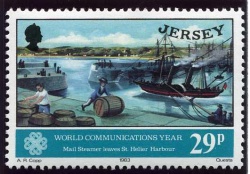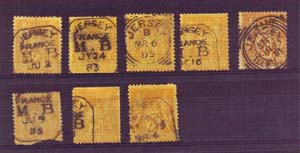No notice of appointment
Whatever the date, it appears that the service was set up in something of a hurry, because nobody thought to advise the States of Jersey of Jersey, and Mr Le Geyt professed in his letter to know nothing about his appointment before Post Office Surveyor Christopher Saveland arrived with the first batch of mail and arrived on Mr Le Geyt's doorstep to announce his appointment.
Mr Le Geyt welcomed the news in his letter of Mr Nepean but expressed concern that the unfavourable rate of exchange which then existed between Jersey, French and English currencies would be to his disadvantage, and requested that his £50 annual salary be increased. He soon took matters into his own hands and levied a fee of 1d on every letter collected from his post office, which was established in Hue Street. This was in addition to the postage charge which had to be paid by the recipients, and that varied according to where the letter had been posted. It was to be nearly another 50 years before the postage rate was set at 1d, regardless of how far a letter travelled, and was paid by the sender.
Act not registered
The 1894 Act of Parliament was not registered in Jersey, a fact which Mr Le Geyt drew to his advantage when the States challenged his right to impose the 1d surplus and asked that postage rates should not exceed those fixed by the Act.
- "It may not be improper to add that, although they quote the Act of Parliament as a rule, they have declined registering it, which it is necessary to do to give it force of Law here; however they do not scruple to cite it, as being subservient to their purpose", was Mr Le Geyt's response.
However, he was given an official allowance to cover his losses and the 1d charge was dropped. The States appeared generally to welcome the new service and wrote to the Postmaster General in August 1794:
- "We the States of the Island of Jersey sensible of the great utility arising from the late appointment of Regular Packets between Weymouth and this place beg leave at the same time to represent to your Lordships that this Island does not reasp all the advantages that might be expected from this excellent establishment on account of some inconveniences which we shall submit to the consideration of your Loprdships and which we conceive it would not be difficult to obviate."
States complaints
The States main criticisms were that the packets should sail from Weymouth to Jersey on Saturday rather than Thursday and should have a shorter stay in Guernsey on the way back. The first point was conceded and by 1807 there were three packets operating two sailings in each direction per week between them. The second point was ignored, and the delays in Guernsey were frequently very long, because the Lieut-Governor of Guernsey, Major General John Small, took advantage of his right to delay sailings 'for reasons of vital importance' and frequently held the mail packet for hours, and sometimes days. This led to strong complaints from Jersey, but the problem disappeared with Small's death in 1796.
Casualties
The packet service from Weymouth was not without its dangers, and vessels were lost to privateers and shipwrecks
The Post Office building in Hue Street was well away from the centre of town and when Le Geyt sought to retire at the age of 82 in 1815 and hand over to his son, one condition was that the post office should be moved to a more central position, and it was accordingly transferred to Minden Place, where the family owned land. It is believed that the street may have been given this name because Charles Le Geyt had fought at Minden while in the army.
Private messengers
In the early days there were no deliveries of mail - recipients had to collect their post from the post office. The inhabitants of St Aubin paid a private messenger to collect all their mail after the weekly packet had arrived, paying him 1½d for each letter he carried, and soon the idea was taken up by those living in the growing town at Gorey.
In 1795 the States wrote to the Postmaster General to inform him that there had been complaints about the delivery and reception of mail, but when the complaint was referred to him, Le Geyt said that there had been no complaints from the public, and all the criticism had come from one States Member, the Constable of St Peter John Dumaresq. In response to his complain that no mail was delivered before 9 in the morning or after 9 at night, nor between 3 and 4 in the afternoon, Le Geyt wrote:
- "Of this Article I trust their Lordships will immediately see the futility. I breakfast at 8, to be ready to open at nine o'clock. I take one hour for my dinner, from three to four) which I hope will not be thought too much; and nine in the evening is surely not too early an hour to shut the Post Office when, having no assistant (except on mail days) I have been from nine in the morning standing upon my legs in the delivery of the letters, and of course exhausted with fatigue."
Home deliveries
In 1798 it was decided to introduce deliveries to homes and businesses, although within a very limited area of the town of St Helier. Mary Godfray was the only letter carrier in the island for the next 32 years. She was not paid, but was allowed to charge ½d for each letter delivered. In 1830 she was given a wage of 6s a week, which was increased to 7s 6d in 1835. In 1843, at the age of 69, she retired, but she was not granted the pension she requested because the Postmaster General did not have the power to grant one to somebody of her rank.
Surveyor's investigation
In 1829 Surveyor George Louis was sent to see how the Jersey Post Office was function and discovered to his dismay that, because the 1794 Act of Parliament had never been registered in Jersey, the Post Office held no monopoly to carry mail and private postal services were being run in competition. A French Post Office was run by Theodore Fontaine, apparently with the approval of the French Government. French stamps were put on letters deposited there and a Jersey postmark was applied.
"We are here surrounded by opposition, every trader and Steam Packet has its Post Office; if the law cannot stop this and secure the whole of the letters being conveyed to the regular Post Office, the reasons are stronger for making such convenient regulations as will cause the Residents to prefer our establishment to that of any other. I have just been looking at the windows of the different offices andhave seen many letters directed to remote Parishes: these letters may remain a length of time on hand, but if my proposition be sanctioned such cannot be the case with those brought to our office."
What George Louis proposed was an island-wide delivery service. Mary Godfrey was given a colleague to help her with town deliveries over a wider area, and no charge was levied for these deliveries on top of the normal postage rates, which were high enough. Five country routes were established and the postmen were paid either 5s or 6s a week
- Town to Millbrook, St Aubin, Noirmont, St Brelade and St Ouen (involving a walk of between 30 and 40 miles)
- Beaumont to St Peter, St Mary and St John
- St John's Road, St Lawrence and Trinity
- St Saviour, Georgetown, Havre des Pas, St Clement, Pontac, La Rocque
- Grouville Village and parish, Gorey, St Martin and Rozel.
Further articles
- Postal history, the early years A duo of different histories to the set above
- Postal history, later on










